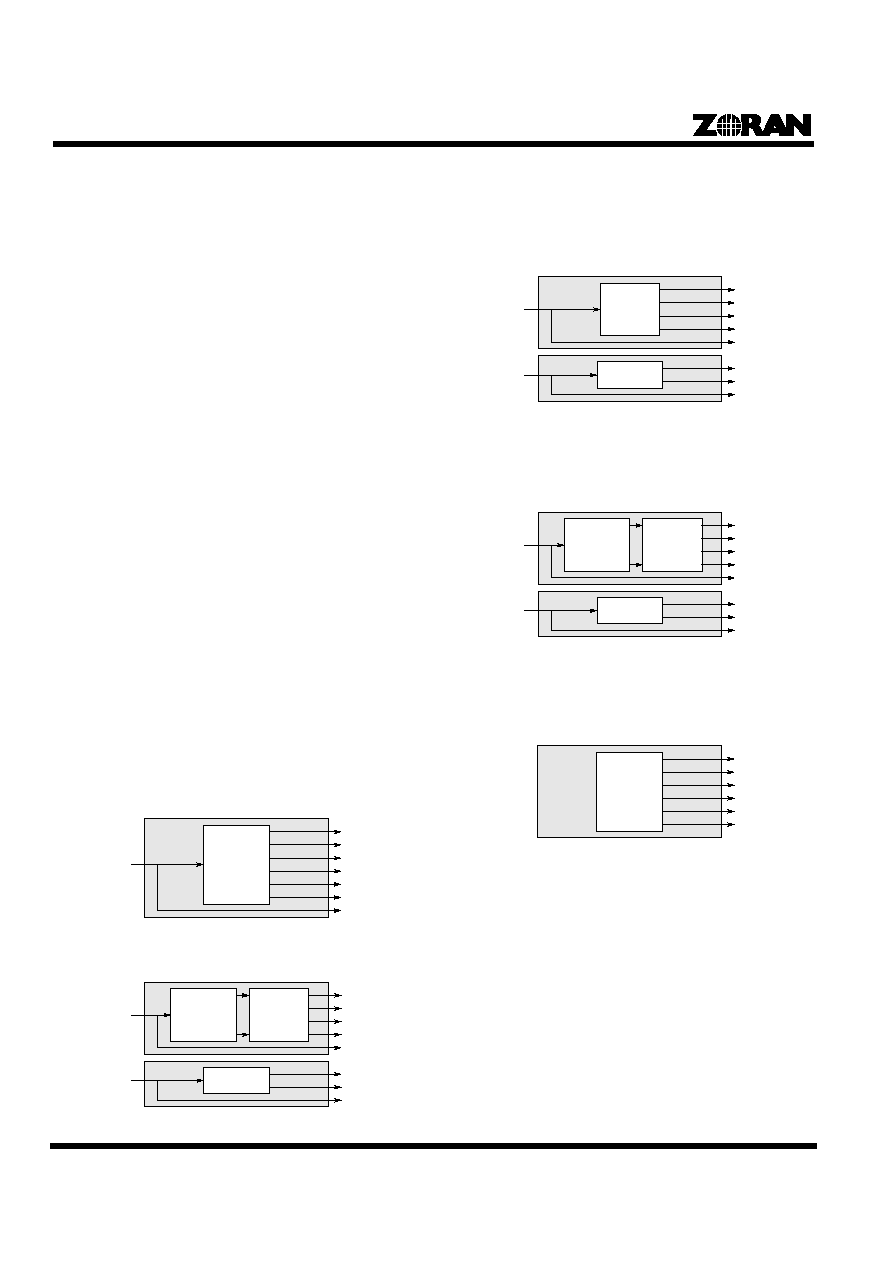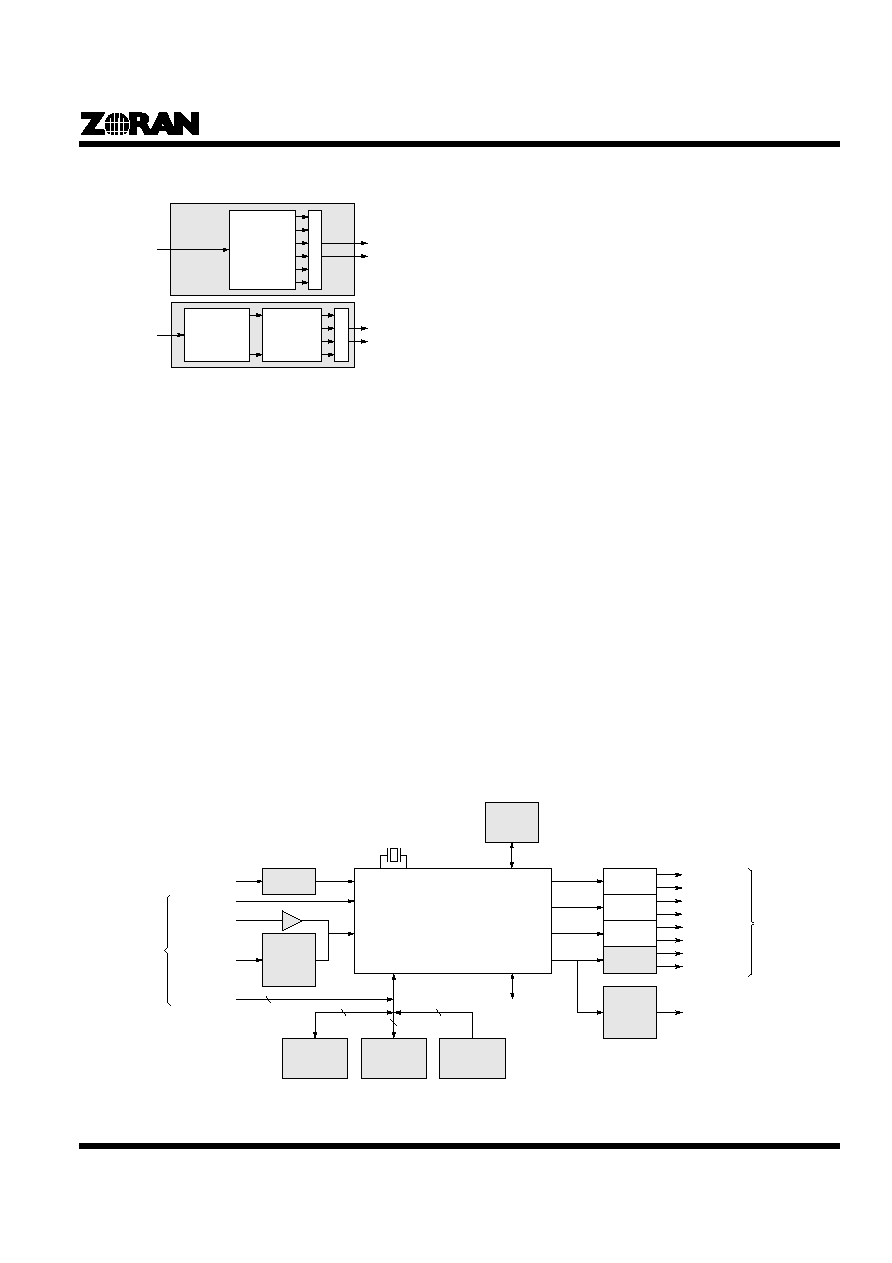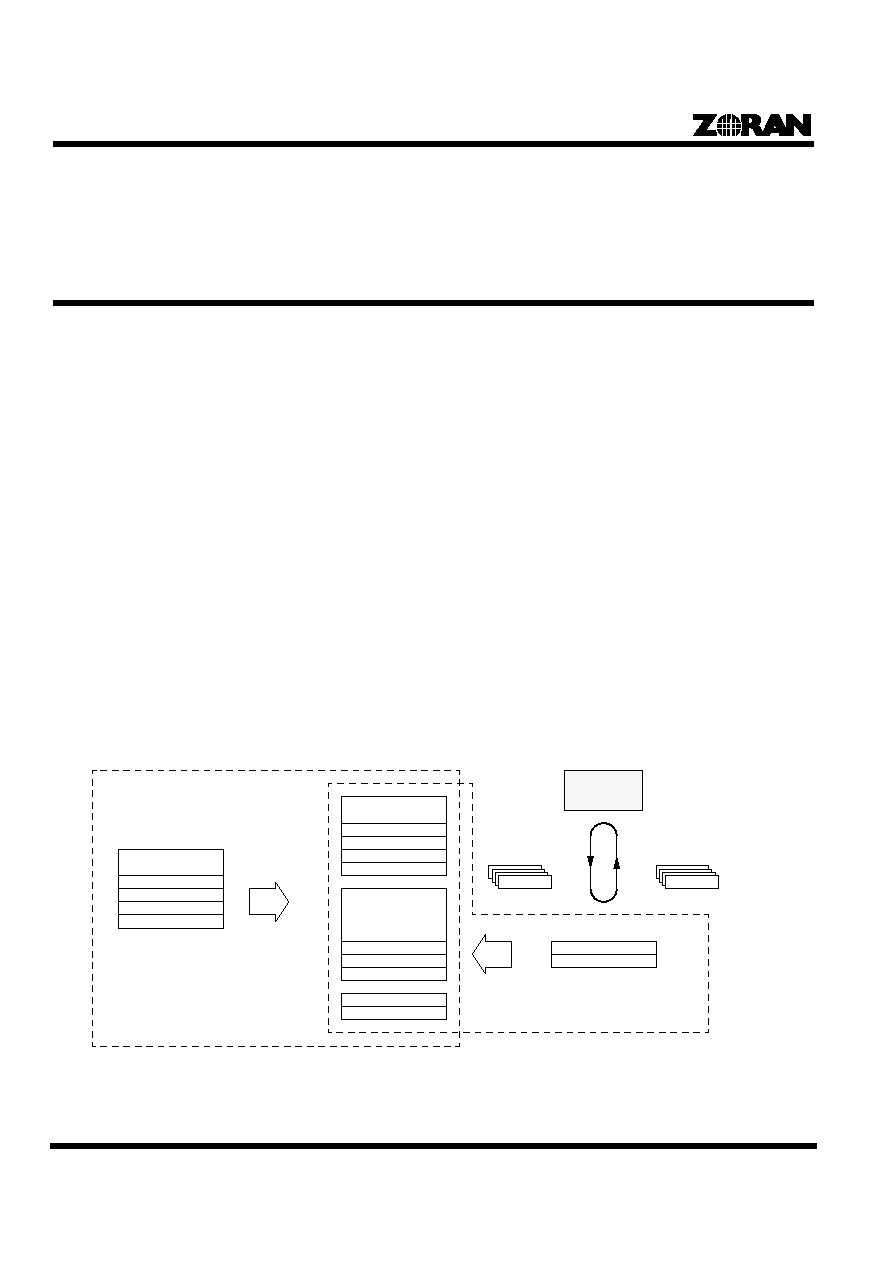
15 February 1999
ZORAN Corporation
3112 Scott Blvd.
Santa Clara, CA 95054
+1 (408) 919-4111
FAX +1 (408) 919-4122
www.zoran.com
DATA SHEET
ZR38650
PROGRAMMABLE DIGITAL AUDIO PROCESSOR
FEATURES
Full-Function Digital Audio Processor Hardware
- 50 MIPS performance with multi-operation instructions
- Large internal RAMs/ROM plus low-cost external memory
- Wide selection of on-chip digital audio peripherals
- Flexible interface for host or no-host operation
Standard Software Functions in ROM
- Dolby Digital AC-3, 5.1 channel and 2 channel decoding
up to 640 Kbits per second
- Dolby Pro Logic encoding and decoding
- MPEG1 and MPEG2 two channel decoding with MPEG2
PES stream parsing, PTS decoding and SCR handling
Downloadable
SiliconSoftwareTM Functions
- Tomorrow's ever-changing standards plus today's:
- Aureal A3D, Dolby Virtual Surround, Harman VMAx
- QSound QSurroundTM, Spatializer N-2-2TM, Home THX
- SRS TruSurround, Music Modes, Bass Management
Flexible Input/Output
- Serial and/or parallel data stream I/O
- Serial SPI, serial Z2C or 8-bit parallel host interface
- 3 serial input data ports and 4 serial data output ports
- Formatted S/PDIF receiver with up to 96 kHz sample rate
- Sample rates: 32 kHz, 44.1 kHz, 48 kHz or 96 kHz
- Formatted S/PDIF AC-3 and MPEG transmitter output
Low System Cost
- Host-less operation with no glue chips
- Separate internal PLLs for DSP core and audio I/O
- No external RAM required for 5.1 Dolby AC-3/MPEG2
- Wait-state generation for low-cost external memory
- 144-pin Plastic Thin Quad Flat Pack (TQFP) package
- 3.3 V supply with 5 V compatible I/O for low power
DESCRIPTION
The Zoran ZR38650 is a full-function, high performance pro-
grammable digital audio signal processor. It is today capable of
real-time single-chip decoding of Dolby Digital AC-3 and
MPEG2 digital surround algorithms with its standard ROM and
SiliconSoftware functions. It is also today's best digital audio
platform for meeting tomorrow's constantly evolving digital audio
algorithm requirements. Using the proven ZR38000 architec-
ture, it is the fourth generation audio processor made by Zoran.
Because of its programmable high performance and high level of
integration, the ZR38650 is unusually flexible in meeting a wide
range of system requirements at the lowest possible system
cost. At the low end it can provide standard fixed decoding func-
tions with only a DAC and an optical interface for the S/PDIF
input in addition to the oscillator crystal. At the high end it can
provide eight channels of output, analog input, long-delay mem-
ories, custom operating features and the ability to be upgraded
with downloaded
SiliconSoftware product enhancements. Yet all
of this flexibility comes without design complexity. Highly config-
urable standard functions with a simple command structure
minimize software development, while a full set of development
tools are available for the highly-custom product developer.
The ZR38650 is suitable for primarily audio applications such as
Audio/Visual home theater receivers, Digital Audio Broadcast
(DAB), 3-D audio, six-channel speaker systems and Karaoke
processors; primarily video applications like SDTV and HDTV
stereo television receivers, digital cable and satellite TV set-top
boxes; and multimedia applications with both audio and video
like Multimedia PCs and the Digital Video Disk (DVD) players.
DAC
Right
Left
Right Surround
Left Surround
S/PDIF
Optical
Interface
S/PDIF Input
XTAL
ZR38650
Subwoofer
Center
Host
Processor
(Optional)
SPI or Z2C Serial Interface
Encoded Data
Input
Decoded Audio
Outputs
General Purpose Control I/O
Right Center
Left Center
DAC
DAC
DAC
(Optional)
Figure 1. A Typical Low-Parts-Count ZR38650 System

2
ZR38650
GENERAL DESCRIPTION
The Zoran ZR38650 is the latest full-function digital audio pro-
cessing member of the ZR38000 digital signal processor
product line. It is especially configured with peripherals, I/O
capability and software for digital audio. Today, quality digital
audio starts with a primary decoding function and adds appropri-
ate data stream protocols and interfaces with I/O configurations
to match the application. The ZR38650 has these primary
decode and protocol software functions and yet has pro-
gram/data memory and processing cycles left for additional
product-distinguishing features. The ZR38650 also has the nec-
essary flexibility in system I/O and hardware configuration.
The ZR38650 is instruction-set compatible with the earlier
ZR38600, but has a higher 50-MIPS processing rate. This gives
the new faster 96-kHz sample rate S/PDIF decoding and
increased processing cycles for additional functions. Larger
internal program and data RAMs and ROM along with wide
external memories accommodate today's rapidly changing
needs for large complex algorithms. Other new hardware
features are a programmable timer, a Z2C serial host interface
and more support for the 24-bit I/O data formats.
Functions
AC-3 and MPEG with variations are the primary decoding func-
tions in use today. The ZR38650 has these and their associated
test function with the required set-up, operation and system
functions to make them usable in an end-user product. In addi-
tion, an ever increasing number of
SiliconSoftware functions can
add special enhancing and differentiating features to products.
Primary Decoding and Test Functions
AC-3
The figure shows the simultaneous S/PDIF input and 5.1
channel DAC (Digital-to-Analog Converter) outputs of this
primary digital audio function, the six-channel AC-3 decoder.
Or with four channels of Pro Logic output in either of two DAC
forms: four channels directly or to an analog Pro Logic decoder.
PCM + Pro Logic
With two-channel PCM inputs the choice of functions is four-
channel Pro Logic decoding or two-channel stereo mixing,
including upmixing from only one input channel to two.
MPEG
The MPEG1 decoder accepts either MPEG1 or MPEG2 input
streams and produces either Pro Logic DAC outputs or two-
channel stereo in DAC form.
Pink Noise
A six-channel pink pseudo-random noise generator function is
included for user testing of speaker balance in their listening
space. Individual speakers can be enabled in any combination.
SiliconSoftwareTM Functions
SiliconSoftware is a group of additional functions for the
ZR38650 provided by Zoran or third-party suppliers that can add
special features now or provide new functions in the future.
3-D Audio
Currently there are six providers of 3-D audio which gives the
effect of a three-dimensional sound field with only two speakers.
These functions are Aureal A3D, Dolby Virtual Surround,
Harman VMAx, QSound QSurroundTM, Spatializer N-2-2TM and
Six-Channel
AC-3 Decoder
Left
Right
Center
Subwoofer
Six-Channel
AC-3 Stream
Left Surround
Right Surround
S/PDIF
Two-Channel
AC-3
Decoder
Pro Logic
Decoder
Left
Right
Center
Surround
Six- or Two-
Channel AC-3
Stream
S/PDIF
Lt (Pro Logic)
Rt (Pro Logic)
S/PDIF
Six- or Two-
Channel AC-3
Stream
AC-3
Decoder
Two-Channel
PCM Input
Pro Logic
Decoder
Left
Right
Center
Surround
S/PDIF
Left
Right
S/PDIF
One- or Two-
Channel PCM
PCM Mixer
Two-Channel
MPEG1
Decoder
Pro Logic
Decoder
Left
Right
Center
Surround
Two-Channel
MPEG1/MPEG2
Stream
S/PDIF
Left
Right
S/PDIF
Two-Channel
MPEG1/MPEG2
Stream
MPEG1
Decoder
Pink Noise
Generator
Left
Right
Center
Subwoofer
Left Surround
Right Surround

3
ZR38650
SRS TruSurround. They work with either two- or six-channel
inputs and the AC-3 or MPEG decoders.
Bass Management
Selected low-frequencies can be redirected to different
speakers with Bass Management. Useful with all types of
decoding to compensate for the types of speakers used.
DVD - Linear PCM
Special provisions are included for data formats and synchroni-
zation for AC-3/MPEG decoding with 3-D audio and bass
management for Digital Video Disk (DVD) applications.
Hall Effects/Music Modes
Adds the natural acoustical effects of a performance environ-
ment to the original recording environment.
Home THX5.1
Theater THX for use in consumer home entertainment systems.
Karaoke Processing
Voice cancellation, pitch-shifting and echo and reverberation.
Custom Functions, Etc.
Product designers can always add custom functions and varia-
tions, often with very simple software additions.
Operation and Set-Up Functions
These control the simple start and stop operation of the
decoding functions and determine the initial hardware operation
and configuration.
System Functions
These functions control the real-time operation including inter-
face transactions, program loading and in-circuit testing.
System Configurations
The ZR38650 is highly self-contained and can work with few
external parts as shown in Figure 1. However it is very flexible in
accommodating the needs of larger, higher performance
systems. Figure 2 shows all of the possible options that are sup-
ported to make a complete system.
Hosts
The ZR38650 does not require a host microprocessor but if
there is one in the system it may be used to advantage. Either
the bit-serial SPI (Small Peripheral Interface) or Z2C interface,
or a byte-wide parallel interface may be used.
Data Input/Output
The encoded digital input data stream can use a bit-serial or
byte-parallel interface or S/PDIF receiver with the ZR38650
either a master or slave. Up to six-channels of analog signals
can be input in bit-serial ADC (Analog-to-Digital Converter)
formats in a master or slave mode.
Six-Channel
AC-3 Decoder
Six-Channel
AC-3 Stream
Left
Right
3-D Audio
Two-Channel
AC-3/MPEG1
Decoder
Pro Logic
Decoder
Left
Right
Two-Channel
AC-3/MPEG1/
MPEG2 Stream
3-D Audio
DAC
Right
Left
Right Surround
Left Surround
S/PDIF Input
XTAL
ZR38650
Subwoofer
Center
Z2C or SPI Serial Interface
Encoded
Data Input
Decoded
Audio
Outputs
General
Purpose I/O
Right Center
Left Center
DAC
DAC
DAC
(Optional)
Figure 2. ZR38650 Composite System Block Diagram
S/PDIF
Optical
Interface
(Optional)
Lt/Rt
Byte-Wide
Program ROM
(Optional)
Program/Data
RAM or ROM
(Optional)
Host
Processor
(Optional)
S/PDIF
Optical
Interface
(Optional)
Host
Processor
(Optional)
S/PDIF Input
Bit-Serial Input
ADC
(Optional)
Analog Input
Parallel Input
Parallel Interface
8
32
8
8

4
ZR38650
Decoded audio outputs can be up to eight channels in bit-serial
DAC formats or six encoded channels from the S/PDIF
transmitter.
Memory
External memory is not normally needed but can be added for
program and/or digital audio data. Additional byte-wide program
storage gives different or additional functions when a host is not
used and allows a choice of ROM technologies to be employed
for future upgradability at minimum cost and parts count. Wider
32-bit program storage allows directly executing large functions
without downloading. External data memory may be required for
functions with long acoustical delays, input buffering or large
data tables.
FUNCTIONAL DESCRIPTION
A more complete description of the ZR38650 software's opera-
tion and configurations and its hardware configurations follows.
Software - Operation
One of the major benefits of the ZR38650 is its ease of use for
the system developer under a broad range of system require-
ments. Standard functions are easy to use, yet custom features
can be added without falling back to custom software develop-
m e n t w i t h c o m p l i c a t e d r e a l - t i m e o p e r a t i n g s y s t e m
considerations or detailed I/O protocols. This follows from the
fact that all software functions are supplied with a common
command and response sequence for use with a host or an API
(Application Programming Interface) for calling from an internal
program. And each provides for adding custom functions in not
just one but a series of ways which depend upon the complexity
of the custom function.
This is shown schematically in Figure 3 where the operation,
set-up, primary, and
SiliconSoftware functions are shown in the
middle. Using the system utilities to maintain the communica-
tions with the host, the host can issue a sequence of commands
with responses to control the ZR38650's operation. The utilities
issue API calls to the functions. All of the software development
can be limited to the host microprocessor even when feature
types of variations in operation are based on getting information
back from the ZR38650's operation.
Alternatively, the control information in the commands can be
entered in a sequence of API calls issued from a custom
program running internally on the ZR38650 processor. Now no
host is required.
With either a host command/response stream or API calls,
custom functions in native ZR38001 code can be added without
losing the benefits of the ease of use in the common structure.
Table 1 is a summary of the commands and responses for the
standard primary, operation and set-up functions. Note there are
read and write commands to the ZR38650 and responses back
from the ZR38650 to the host. Responses are due to commands
during normal operations that are in progress or from certain
specific commands with read commands following.
Set-up B
Operate B, Etc.
Set-up A
Custom ZR38650
Control Program
Host Processor
With Control
Program
Function B
Function C, Etc.
Function A
Primary Decoding,
Test and
SiliconSoftware
Functions
Command Stream
PLAY Operation
CFG Set-up, Etc.
Operation and
Set-Up Functions
SETIO Set-up
STOP Operation
APIs
Operate A
ZR38650 Resident Control Program
Host Resident Control Program
Monitor
System Functions
Figure 3. ZR38650 Operation Control: Commands from a Host or Calls from a ZR38650 Resident Program
Set-up A
APIs
Utilities
System Functions
Response Stream
Response A

5
ZR38650
Table 1: Standard Function Command and Response Summary
Class
Name Description
Write Command
Commands to ZR38650 to perform a specific function
Primary Decoding
And Test
Functions
AC3
Select AC-3 or AC-3 + Pro Logic decoder function
PCMPROL
Select PCM or Pro Logic decoder functions with PCM input and mixer function
MPEG
Select MPEG or MPEG + Pro Logic decoder function
PNG
Select pink noise generator function
USER
Select user defined function
Operation
Functions
PLAY
Resume selected function operation and unmute audio output
MUTE
Mute audio output without stopping the selected operation
UNMUTE
Restore muted audio output while continuing the selected operation
STOP
Stop operation, retain data in input buffer and mute audio output
STOPF
Stop operation, flush the data in the input buffer and mute audio output
STAT
Return decoder status information using the READ command
SPDIFSTAT
Return the S/PDIF input channel status
GETPTC
Return the PTC and STC values for timing synchronization
NOP
Not a command, does not affect operation. Will return a Progress response.
Set-Up Functions
PLLTAB
Set the PLL programmable registers
PLLCFG
Define the PLL configuration
CFG
Configure the ZR38650 I/O to the specific system hardware
SETSTC
Set the system time clock and video delay
VER
Return 32-bit ROM version number using the READ command
BOOT
Load and execute the N parameter words of bootstrap program
SPDIFCS
Write the S/PDIF output channel status
PARAM
Define parameters for special functions
INTRP
Interpret: load and execute four parameter words as a ZR38001 instruction
SETIO
Set, test and return general purpose single-bit I/O registers
POKE
Load N 32-bit words to the core processor RAM at the given start address
PEEK
Read N 32-bit words from core processor RAM at the given start address
Read Command
Commands to ZR38650 to return Reply words to the host
READ
Command to ZR38650 to return a Reply word after specific commands
Reply Response
Data words returned to the host as the result of sending specific commands followed by READ commands
AC3STATR
Status and information about the AC-3 stream
PCMPROLR
Status and information about the PCM or Pro Logic stream
MPEGSTATR
Status and information about the MPEG stream
PNGSTATR
Status and information about the PNG stream
VERR
Four byte version number of ROM read by VER command
SETIOR
Two words of GPIOC and GPIO registers
PLLR
Two bits which indicate the PLL lock status
PEEKR
N 32-bit words from core processor RAM specified by PEEK command
SPDIFSTATR
S/PDIF input channel status
GETPTCR
PTC and STC values of 32 bits each
Progress Response
Data words returned to host in the normal process of sending any command
EXPECT
Expected number of parameter words still to be received from host
ISTATUS
Interpreter status




